Baltra Airport: Departure from Quito or Guayaquil to Baltra Island (2 ½-hour flight). Arriving in the
Galapagos, passengers are picked up at the airport by our natural guides and taken to a
ten-minute bus drive to the pier to board the M/Y Coral I or M/Y Coral II.
Black Turtle Cove: Here we can find four species of mangrove in the extensive tidal lagoon system that stretches for almost a mile inland. During our panga ride through the labyrinth we will spot many turtles, herons of several species, sharks and rays. The experience is otherworldly and seems to transport us back to the beginning of time.



Punta Vicente Roca (Isabela Island): This is a spectacular visitor site, surrounded by immense cliffs of the eroded volcano. Studded with resting sea birds such as brown noddies and Nazca boobies, we will enjoy
them in close proximity from our dinghies. Snorkeling here is superb, with certain species of fish only found in the west of the archipelago. We also have a very real chance of swimming with penguins and potentially a plethora of green turtles.
Punta Espinosa (Fernandina Island): The youngest island of Galapagos and one of the most pristine in the world. Fernandina is simply the ëmarine iguana capital of the worldí. This desolate volcanic backdrop is home to a huge concentration of these enigmatic reptiles. Incongruously, sharing the same shoreline, we can find the diminutive Galapagos penguins. Here we also have the exciting opportunity to snorkel with marine iguanas feeding underwater, penguins, turtles and the bizarre, endemic, flightless cormorants.



Urbina Bay (Isabela Island): At the far end of a long, level hike we arrive at a strange phenomenon where large blocks of coral lie completely exposed after a dramatic geological uplift in 1954. Located at the western base of Alcedo Volcano we hope to run into a few very impressive land iguanas as well as some of the volcanoís endemic Galapagos giant tortoises during the wet season.
Tagus Cove (Isabela Island): A well-known hideout and deep water anchorage in the days of pirates, Tagus Cove was also one of the few sites visited by Charles Darwin and the HMS Beagle in 1835. A beautiful hike leads us past an overview of Darwin Lake and on to a stunning volcanic landscape revealing Isabela islandís dramatic northern volcanoes. Once back at sea level the perfect activity is to snorkel along a submerged wall with turtles, lots of fish, penguins and potentially flightless cormorants. You might even be tempted by a panga ride or kayak!



Puerto Egas (James Bay): The black volcanic sand sets this landing apart from most. It is best known for the dramatic shoreline where we meet a host of species that chose to live between land and sea. Particular among these are the endemic Galapagos fur seals which maintain a small colony at the end of our walk. Other species of note include American oystercatchers, sea lions, waders, herons, lava lizards and even Galapagos hawks. An optional visit takes us to an abandoned salt mine famous in its day for supplying salt to mainland Ecuador.
Sullivan Bay: Although, when viewed from the sea, the site does not look especially interesting visitors are always totally enthralled by the amazing beds of pahoehoe lava from the recent flow on the island. It is a landscape and macro photographerís dream. The importance of pioneer plants such as the tiny Mollugo will be discussed as we hike over the lava. After our land visit we can enjoy a refreshing snorkel in the company of sea lions, turtles and rays
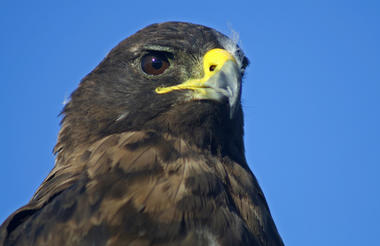
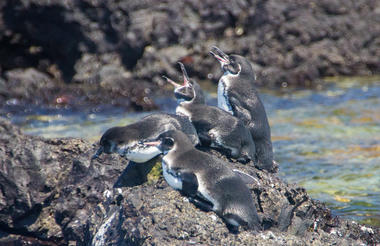

Bachas Beach: Named for some wrecked World War II barges whose ribs are still visible in the sand this visitor site offers great swimming, a lovely walk along the shore and a visit to a lagoon behind the high tide line with wading birds, marine iguanas and sometimes even flamingoes. The two beaches are also favourite nesting sites for green turtles which often leave tractor-like tracks in the sand.
North Seymour Island: This flat, uplifted, island is an important spot to see both magnificent and great frigatebird males courting the females by clicking, bill-clapping, shuddering and flapping their wings, all while showing off their grossly inflated, bright red, gular pouch. We will also likely see courting bluefooted boobies displaying their unique feet while ëdancingí to a prospective mate. Sea lions, swallow-tailed gulls, crashing surf and distant views of the Daphne Islands top off a great visit.
Highlands Tortoise Reserve (Santa Cruz Island): Dry landing. In the mountains of Galapagos is possible to admire different kind of birds, such as: tree and ground finches, vermillion flycatchers, paint-billed crakes, yellow warblers, and cattle egrets (usually standing on the tortoises’ shell). The journey to the reserve offers great opportunities to see the contrasts that the island offers in reference to the variety of ecosystems. The road goes from the coast through the agricultural zone and straight up to the dense humid forests. Often, Galapagos giant tortoises are also seen on the way, wandering through pastures in the paddocks. This spot is a birdwatchers’ haven, since almost every land bird present on the island lives or migrates here.


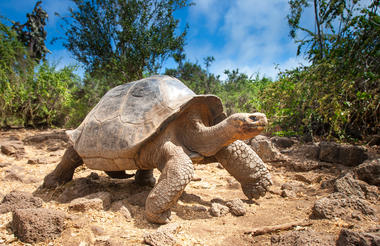
Charles Darwin Research Station (Santa Cruz Island): Once home to the famous Lonesome George, the last tortoise of the Pinta race, the breeding and relocation center is named in honour of his long-time guardian. The center is set in the Galapagos National Park Service where various interpretative buildings are available to visit. The grounds, with large stands of native vegetation are one of the better
places to spot some of the seldom seen Darwinís finches such as the woodpecker, cactus
and vegetarian finches
Mosquera Islet : This tiny, low lying islet, covered in coral sand, is set between North and South Seymour Islands. It is home to a group of sea lions that come to laze on the soft white sand. It is a good spot to observe shorebirds as well as herons, lava gulls and boobies. Snorkeling or diving here one can often see sharks, rays and barracudas.

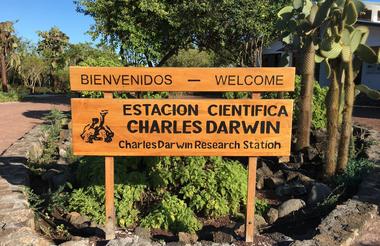

South Plaza Island : Sea lions, swallow-tailed gulls and land iguanas are all present at the landing site. The small island is covered with a carpet of a red succulent studded with Opuntia cacti. At the cliff edge, we spend time watching birds fly past at eye level in the updraught. These include, frigatebirds, flocks of Galapagos shearwaters and of particular note, flights of displaying red-billed tropicbirds. Back at sea level, we once again encounter land iguanas, some of which have hybridized with their resident marine cousins.
Santa Fe Island: After a fabulous snorkel in the turquoise waters of the protected bay we may have enjoyed time with sea lions, turtles, reef sharks and spotted eagle rays. Landing onto a sandy beach we are immediately distracted by the abundant sea lions there with us. We begin a walk past a forest of island-endemic giant Opuntia cacti. Here we search for another islandendemic the Santa Fe land iguana, paler than its cousins on other islands. Galapagos hawks and even endemic rice rats are also things to look out for.
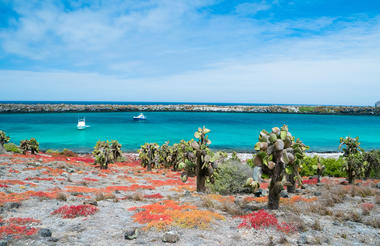
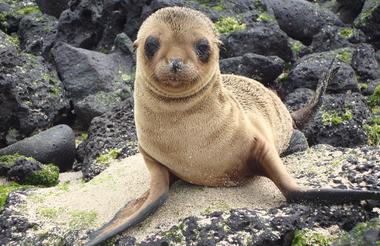
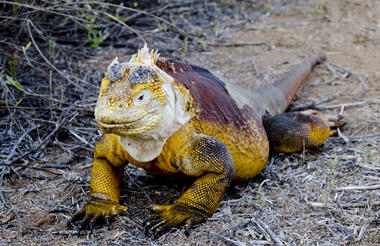
Breakfast
Lunch
Dinner
Lobos Islands & After the visit, passengers will be transferred to the airport for their return flight to Guayaquil or Quito.



Breakfast








